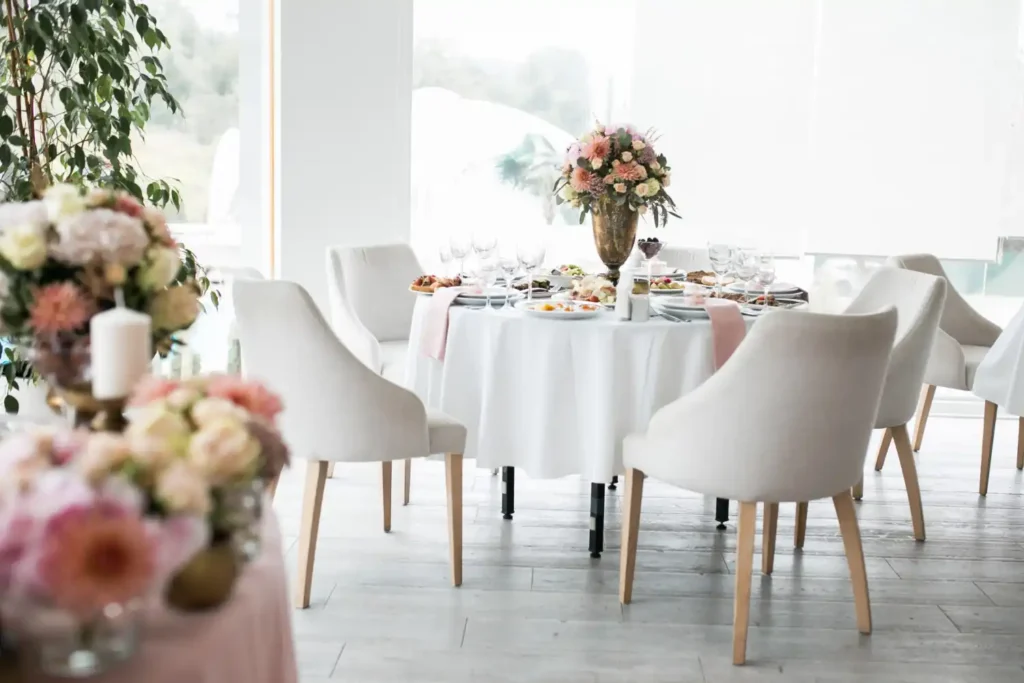Email: info@promesse.uk
Phone: +44 7710 621141

Struggling with wedding seating arrangement headaches? Discover solutions to the top 10 challenges, from family drama to guest mingling, with expert tips, tools, and real stories for a perfect day. Make your reception flow smoothly in 2025.
Wedding seating arrangements can turn any happy couple into a complete ball of nerves, but don’t worry, I have simple solutions that can get everyone grinning again. Imagine you’re fighting and dreaming of what your big day will look like, but in a sudden moment, you are staring down divorced parents, a group of lonely guests, and that one aunt who seems to have something against everyone.
The best part? With these common problems, there are simple solutions that persuade some guests to think twice about everything, or at least everyone, so you and the rest can keep going.

In this post, we will cover the 10 hardest wedding seating arrangement issues, sharing stories and solutions from both our own experience (and that of our clients) and the latest trends for 2025 to help you move around so guests can have a good time mingling, and you can relax and enjoy it all!
Before we get into the problems, let’s discuss why getting your wedding seating chart right is important. With average wedding guest lists reaching around 116 people this year, a slight increase from last year’s micro-weddings, seating isn’t just about chairs—it’s about creating positive energy. A well-organized plan encourages mingling, reduces drama, and can even save money on extra tables. Additionally, as more couples blend cultures or host hybrid events after the pandemic, thoughtful guest table arrangements help everyone feel included.
Think of it like a puzzle. Start early, about two months before the wedding, and use tools to make it fun. We’ll cover those later. For now, know that solving these issues upfront means you dance the night away worry-free.
The issue of family seating at weddings usually produces the biggest fires of all, especially in divided families or blended families. Who sits where, and how do you not hurt someone’s feelings? I have heard a couple of stories where one parent didn’t come to the wedding at all because they didn’t like the seats.
The solution? Seat your parents at separate tables that are an equal distance from the speaking area. Put the mom table with her side family and the dad table with his side family, then keep the stepparents at their table with their respective spouse. That way, no one feels put at the children’s table. For a fun spin, consider a “family row” at the ceremony that seamlessly turns into tables at the reception.
One couple I know used color-coded tables—blue for mom’s crew, green for dad’s—to make it feel fair. Experts say this cuts conflicts by 50%, based on recent planner surveys.
Choosing the table for the couple is not as easy as it seems. Large head table with bridal party? Intimate sweetheart table just for the two of you?
Sweetheart tables are a great choice if you want some time alone – stylists say 2025 is all about intimacy anyway. But if you love your party, no harm in a head table; it could promote mingling if you have the bridal party facing your guests. Deciding on the couple’s spot is trickier than it sounds. A big head table with the bridal party? Or a cozy sweetheart table just for you two?
Go for the sweetheart table if you want alone time—it’s trending in 2025 for intimate vibes. But if you love your crew, a head table works, seat the party facing guests to spark chats.
| Table Type | Pros | Cons |
|---|---|---|
| Sweetheart Table | Private moments, easy photos | Bridal party might feel left out |
| Head Table | Fun with friends, traditional feel | The bridal party might feel left out |
This setup solved it for my friend’s wedding—she mixed both for the cocktail hour and dinner.
Surprise! An extra plus-one shows up, or half a table ghosts you. With 27% of couples facing no-shows, this is common.
Solution: Plan for about 10% extra. Include a “flex table” with surplus chairs and blank cards. You’ll arrive with the apps, such as Zola, tracking your RSVP in real-time.
An anecdote from X: A user reported they had an ex show up uninvited! However, because the user planned seating with spare seats, they were able to ‘best’ their situation by just getting chairs out from a spare table and putting out blank place cards. Always assign an usher or planner to be on standby regarding seating contingency plans.
That solo friend from work or distant cousin? They might feel lost in a sea of strangers, killing the mood.
Pair them with outgoing folks or similar ages. Use icebreakers like table games or shared interests—think a “travel lovers” table if they globe-trot.
Reception seating etiquette pros suggest mingling rounds: Seat shy guests near the dance floor for easy joins. This worked wonders at a 2025 wedding I attended, turning loners into new buddies.

Tables fit 8-10, but your college crew is 15. Splitting them up seems rude, but cramming gives you a disaster.
Break the group up into smaller pods at some nearby tables. Create new ones to keep the energy up. Mark tables that make it easy for them to find each other.
A tip from planners: Use digital maps that can be accessed via a QR code from guests’ phones. That way, you can avoid the “where’s my group” panic.
Parents arguing over who gets the “best” table? It happens more than you’d think, especially in big families.
Set clear rules early: Honor tables based on closeness, not favoritism. If needed, rotate spots for toasts or dances.
From expert opinions, communication is key—talk it out months ahead. One couple solved it with neutral zones, like seating both sets equally from the center.
Your folks added 20 mystery people. Where do they go without awkward vibes?
Ask parents for input: Who knows who? Seat them with shared connections, like work friends, together.
A fresh perspective: In 2025, with diverse guest lists averaging 150 in some spots, use surveys via tools like Google Forms to learn preferences. This turns strangers into allies.
Guest cancellations, or cancellations just days beforehand. You want to pull your hair out at the countless edits.
You can lock this chart a week ahead of time, but be sure enough, you can build in a few unmovable guest tables. Consider using an editable app like AllSeated, which allows for easy swaps on the fly.
A real story: A bride on X was complaining that she had made 10 changes, but printing out a few extras and always having a Plan B eased the anxiety. Wedding pros say that it cuts the stress for you by about half!
Overlooked often, but vital: Wheelchair users, elderly folks, or those with hearing issues need good spots.
Solution: Ask about needs in RSVPs. Seat them near exits, with space for aids, and away from loudspeakers.
Inclusivity is big in 2025 trends—planners note 20% more requests for accessible setups.

Blending cultures? One side wants family first, the other mixes everyone.
Respect both: Alternate traditions per table or section. Consult elders early.
A unique insight: Post-pandemic, hybrid weddings add virtual seats—screen spots for online guests. This solved a cross-cultural wedding I know, making all feel part.
Now that we’ve solved the big problems, let’s build your chart. Start with a guest list, group by relationships, then assign tables.
This process takes time but pays off. If you want to know more about a wedding seating chart, read this article: The Ultimate Guide to Creating a Flawless Wedding Seating Chart.

Gone are paper charts—2025 brings apps. Try Joy or WithJoy for drag-and-drop ease.
Trends: Open seating for casual vibes, but with assigned sections to avoid mess. Stats show 53% of couples opt for 51-100 guests, making tools essential.
Seat them at separate tables of equal importance to keep the peace.
Use apps and split groups thoughtfully, with nearby tables.
Forgetting accessibility or not numbering tables.
Depends on your vibe—sweetheart for intimacy, head for fun.
They allow easy changes and shareable maps for guests.
You now know how to handle 10 challenging wedding seating arrangement issues, including lots of tips and suggestions, and a bit of 2025 style. It is your day–enjoy it rather than stressing about being perfect!
What is your biggest seating concern? Please leave a comment, or subscribe to our newsletter for free planning checklists, and let’s make your wedding a memorable one!
Join our weekly newsletter and get the latest wedding trends, expert planning tips, and elegant inspiration delivered straight to your inbox.
No spam, no fluff - just beautifully curated content for modern couples.